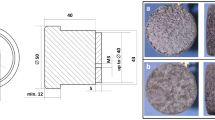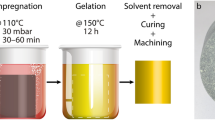Abstract
Polymeric composites are vastly employed in ablative Thermal Protection Systems of hypersonic vehicles. Due their high velocity and altitude of flight, such vehicles are subjected to a high variation in atmospheric pressure, which affects the ablative process over the heat shield. This study evaluates the influence of pressure environment in the ablation through experiments performed in a vacuum chamber, where the samples of carbon–phenolic composite were tested for two different pressures at prescribed heat fluxes impinged by a plasma torch. A reliable physical model is proposed, and numerical results are compared with experiments, presenting good agreement and revalidating the simulation model. The specific mass loss rate at rarefied pressure was compared with the one at atmospheric pressure, and a reason for the difference is explained. Recession surfaces were simulated and compared to the experiments. Tested samples were analyzed by FEM and, results are discussed.
























Similar content being viewed by others
Abbreviations
- A :
-
Interface area, m2
- C :
-
Concentration of reactants and product
- C g :
-
Dimensionless proportionality constant
- Cp :
-
Specific heat at constant pressure, J/kgK
- Ea :
-
Activation energy, J/s
- k :
-
Thermal conductivity tensor, W/mK
- K r :
-
Reaction constant
- L :
-
Transformation heat (pyrolysis or ablation), J/kg
- q :
-
Source term of energy per area unit at interface, W/m2
- q CO2 :
-
Combustion heat of CO2, J/kg
- q e :
-
Prescribed external heat flux, W/m2
- q g :
-
Rate of heat generation per unit mass of product at a temperature T, J/kg
- \({\dot{q}}_{g}\) :
-
Additional heat flux on the external surface, W/m2
- \({\dot{m}}_{g}\) :
-
Rate of product formation of the reaction per surface area, kg/m2s
- P:
-
Gas pressure, Pa
- Q :
-
Liquid heat exchange on interface, W
- R :
-
Gas constant, J/kgK
- t :
-
Time, s
- T :
-
Temperature, K
- \({T}_{F}\) :
-
Interface temperature, K
- \({T}_{\infty }\) :
-
External temperature, K
- V :
-
Interface velocity, m/s
- \({V}_{p}\) :
-
Recession velocity of the pyrolysis front, m/s
- x :
-
Point position in the coordinate system, m
- x F :
-
Interface position in the coordinate system, m
- \(\varepsilon\) :
-
Emissivity
- \(\delta\) :
-
Dirac delta, ranges from 0 to 1 depending of the point position in relation to interface
- \(\rho\) :
-
Specific mass, kg/m3
- \(\sigma\) :
-
Boltzmann constant, W/m2K4
- C:
-
Carbon
- O2 :
-
Oxygen
- CO2 :
-
Carbon dioxide
References
Barbosa CAL (2004) Obtenção e caracterização de materiais ablativos a base de compósitos de fibra de carbono/resina fenólica. Instituto Tecnológico de Aeronáutica, São José dos Campos
Silva SFC, Machado HA, Bittencourt E (2015) Effect of the fiber orientation relatively to the plasma flow direction in the ablation process of a carbon-phenolic composite. J Aerosp Technol Manag. São José dos Campos, 7(1):43–52
Nguyen-Bui NTH, Duffa G, Dubroca B, Leroy B (2006) New methods for the simulation of ablative thermal protections. In: European workshop of thermal protection systems and hot structures, 5, Noordwijk
da Costa LEVL (2003) The composite option for solid rocket motor cases in Brazil. In: International Astronautical Congress of The International Astronautical Federation, The International Academy of Astronautics, And the International Institute of Space Law, 54, Bremen. Reston: AIAA.
Auweter-Kurtz M (2002) Plasma source development for the qualification of thermal protection materials for atmospheric entry vehicles at IRS, Vacuum, 65(3–4):247–261
Bittencourt E et al (2018) Effect of the atmosphere in the ablation of carbon-phenolic composites used in thermal protection systems. In: 4th Brazilian Conference on composite materials. Rio de Janeiro: BCCM
Charakhovski L et al (2008) Hypersonic and subsonic plasma setups for testing heat shielding materials. In: Brazilian Congress of thermal engineering and sciences, 12, 2008, Belo Horizonte. Rio de Janeiro: ABCM
Pesci PGS et al (2018) Numerical-experimental analysis of a carbon-phenolic composite via plasma jet ablation test. Mater Res Exp, 5:065601
Machado HA, Silva SFC (2017) Numerical simulation of ablation of a carbon-phenolic composite via an interface tracking method. In: International symposium on advances in computational heat transfer. 3028, Napoli, Italy. Turkey: ICHMT
Williams SD, Curry DM (1992) Thermal protection materials—thermophysical property data (Nasa Reference Publication 1289). Washington: NASA, dez
Sutton K (1970) An experimental study of a carbon-phenolic ablation material (Nasa Technical Note TN D-5930), Washington: NASA, set
Sykes GF (1967) Decomposition characteristics of a char-forming phenolic polymer used for ablative composites (Nasa Technical Note TN D-3810), Washington: NASA, fev
Natali M et al (2016) Ablation modeling of state of the art EPDM based elastomeric heat shielding materials for solid rocket motors. Comput Mater Sci 111:460–480
Kuo KK (1986) Principles of combustion. John Wiley & sons, New York, p 810
Acknowledgements
Authors would like to thank the participants of the previous work [6], where most of the inspiration for this study was extracted from.
Author information
Authors and Affiliations
Corresponding author
Additional information
Technical Editor: Andre Cavalieri.
Publisher's Note
Springer Nature remains neutral with regard to jurisdictional claims in published maps and institutional affiliations.
Rights and permissions
About this article
Cite this article
Pesci, P.G.S., de Paula e Silva, H., Rita, C.C.P. et al. The effect of environment pressure in carbon–phenolic composite ablation. J Braz. Soc. Mech. Sci. Eng. 43, 500 (2021). https://doi.org/10.1007/s40430-021-03210-2
Received:
Accepted:
Published:
DOI: https://doi.org/10.1007/s40430-021-03210-2




